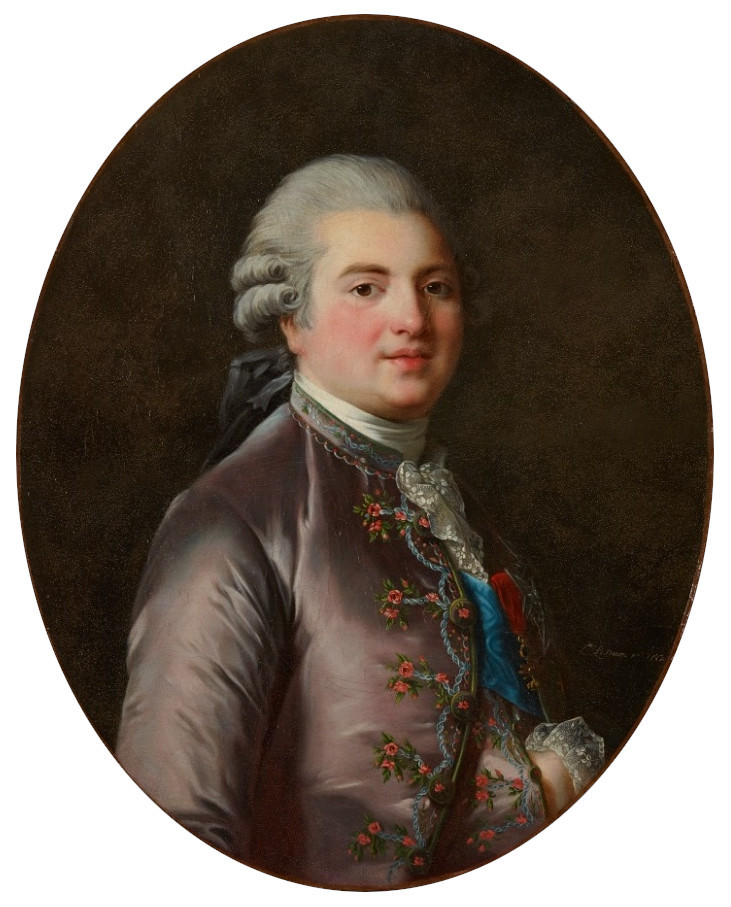
PROVENCE comte de (EN)
Biographical article
The grandson of King Louis XV (1710–1774), the young prince Louis Stanislas Xavier de France was bestowed at his birth, on 17 November 1755 in Versailles, with the title of Comte de Provence. His parents, the Dauphin Louis de France (1729–1765) and the Dauphine of France, Marie-Josèphe de Saxe (1731–1767), soon realised that the child was highly intelligent. He married the Princess Marie-Joséphine-Louise de Savoie (1753–1810) in the royal chapel of the Chateau of Versailles, but the couple had no children.
Despite his taste for the opulent and the ceremonial, the Comte de Provence, called ‘Monsieur’, was also a philosopher prince. He was the heir apparent to the throne of France, until the birth of his nephew, the Dauphin, in 1781. He played an ambiguous political role with regard to his brother, Louis XVI (1754–1793), and he tried in every way to gather around himself all the most important figures in the court to transcend his position as a mere younger brother and attain all his ambitions (Rose, P., 2013).
At the dawn of the Revolution, he led an opulent lifestyle and held a strategic position. In October 1789, he accompanied Louis XVI and the royal family when they were forced to leave Versailles, and he moved into the Hôtel du Petit Luxembourg in Paris. He emigrated with the Comtesse de Provence in June 1791, to the Austrian Low Countries, and then visited all the European courts. After the fall of the First Empire, he ascended to the French throne during the Restauration in 1814, with the title of Louis XVIII, and he reigned until his death in the Palais des Tuileries, on 16 September 1824.

Domaine public / CC BY-SA 3.0
The collection
The Comte de Provence was a shrewd collector of objets d’art rather than paintings or sculptures, a taste he shared with his wife, Marie-Joséphine-Louise de Savoie. Monsieur had luxurious beautifully furnished and decorated apartments, in the royal residences (Versailles, Fontainebleau, Marly, and Compiègne) and in his private dwellings, in the Chateau de Brunoy (Essonne) and the Palais du Luxembourg, in Paris. He also owned the Chateau de Grosbois in Boissy-Saint-Léger (Val-de-Marne) and the Pavillon de Balbi, built in 1785 for his favourite mistress near the King’s vegetable garden in Versailles.
The description of all his possessions inventoried during the Revolution (AN/O2 470) indicated a particular taste for Sèvres porcelains with Chinese decorations, objects of curiosity from the ‘Middle Kingdom’ with a group of ‘eight figures of Chinese walkers made from terracotta and painted in colours and heightened with gold on several areas of the clothing and drapery, and movable heads’, several intricately decorated Chinese porcelain vases enriched with chased and gilt bronze mounts (Musées des Chateaux de Versailles et de Trianon, and private collections). The library of the Comte and Comtesse de Provence comprised several books and accounts about China, including an edition of the Description géographique, historique, chronologique, politique et physique de l’Empire de la Chine et de la Tarrarie chinoise by Jean-Baptiste Du Halde (1674–1743), and the Histoire générale de la Chine ou Annales de cet Empire…, by Joseph-Marie-Anne de Moyriac de Mailla (1669–1748) (Bibliothèque Nationale de France, Paris, and the municipal library in Versailles).
With regard to the furnishings, the Comte de Provence bought from his exchequer items of furniture featuring the latest tastes in marquetry, and mahogany articles, often from the cabinetmaker Jean-Henri Riesener (1734–1806). In the royal houses, the Garde-Meuble de la Couronne (Crown Wardrobe) provided him with several pieces of French furniture veneered with Far-Eastern lacquered panels. In 1787, for the inner Cabinet of his vast apartment located at the end of the Midi Wing in Versailles, he took delivery of the exceptional large flat desk—originally delivered by the cabinetmaker Gilles Joubert on 29 December 1759 for Louis XV in Versailles—adorned with Chinese lacquer panels with a red ground (Wrightsman Collection, Metropolitan Museum of Art, New York) (Kisluk-Grosheide, D., 2006).
Related articles
Collection / collection d'une personne

Personne / personne

